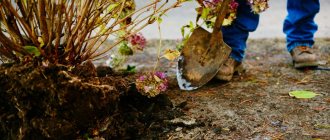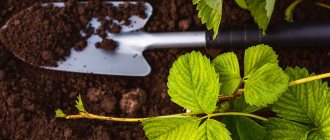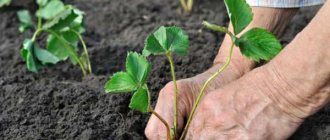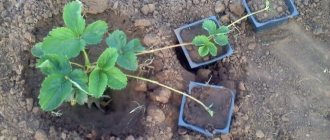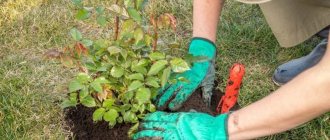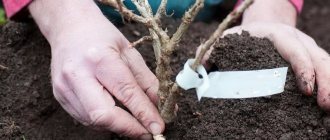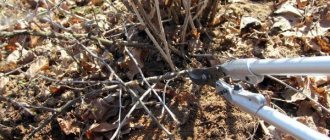Fruits and berries » Strawberries
0
782
Article rating
Kira Stoletova
At the end of the summer season, work on the site does not end. In addition to clearing the beds of carrion, weeds and vegetation debris, you should start replanting some crops. Let's consider when and how strawberries are transplanted in the fall, as well as what kind of care they require.
How to replant strawberries in the fall - basic rules
Why is it necessary to replant?
The main reason for transplanting a plant to another place is to further increase the yield.
A necessary measure to rejuvenate the plantation and preserve the harvest is to replant strawberries in the fall. When moving to another place, it is important to divide the plant or plant it using tendrils. There is no point in replanting a whole bush in a new place, because... an adult plant does not bear fruit as efficiently.
Main reasons for transplantation:
- Berries growing in one area for 3-4 years become small and lose their juiciness. The plant may stop bearing fruit altogether.
- The soil becomes depleted after a few years. Necessary microelements are not enough for the proper development of strawberries.
- Bacteria and fungus multiply in the soil over time. Timely moving to a new place will help avoid diseases and death of the plant.
- The whiskers that extend from the buds rise higher and higher on the stem every year. During the winter period they freeze, which leads to rapid aging of the plant.
- The accumulation of groundwater and the formation of lowlands are the reason for moving the beds.
Site preparation and fertilization
Preparations should be made several months, and sometimes six months in advance. The applied fertilizers need time so that they have time to saturate the soil with all the useful microelements.
Apply mineral and organic fertilizers when digging; over the winter they will saturate the soil with all the useful substances that the plant needs for full growth and development.
The site is dug up and phosphorus fertilizers, ammonium nitrate, and manure are added to the soil. Green manure has a positive effect on the soil - all weeds, fallen leaves from trees and bushes, and tops. Make sure that all these green fertilizers are not affected by any infections.
| Name of fertilizer | Norms |
| Orthophosphorus fertilizers | 100 g/m2 |
| Manure | 3 kg/m2 |
| Ammonium nitrate | 50 g/m2 |
| Green manure | 1-2 kg/m2 |
Strawberries also need a lot of potassium. It must be applied in spring, summer and autumn. Before planting, add 25 g of potassium fertilizer into the hole. Make the soil loose, slightly acidic and loamy. If the predecessors are peas or beans, then you will not need to introduce nitrogen fertilizers and be afraid of contracting any diseases. If not, then treat the soil with copper sulfate or other disinfectants to be on the safe side.
Time for transfer
The time for transplantation should be chosen based on the weather
The most optimal time for transplanting strawberries to a new place is autumn. You can begin gardening work as early as September, but experts recommend paying attention to the weather and climatic conditions in the region. If autumn is dry and hot, then it is better to postpone replanting for a month. When transplanted to a new place in the autumn, you can expect a rich harvest by the next season.
Advantages of transplanting in the fall:
- heavy and frequent rains will help take root;
- cool ambient temperature;
- the soil is warm and with high humidity;
- the plant will be able to get stronger before frost;
- after transplantation, flowering is expected by spring;
- absence of aggressive sunlight;
- seedlings will require less care;
- reduction of work scope at the end of the season.
Benefits of autumn planting strawberries
For strawberry bushes, autumn replanting, or more correctly summer-autumn (depending on the region), is the most favorable period, as it carries many positive aspects.
- At the end of the warm season, the price of seedlings decreases significantly, and their diversity increases.
- Compared to the spring period, at this time gardeners have much less trouble on their land, since most of the harvest has already been harvested.
- Due to the short daylight hours, it takes much less time to care for plants.
- The intense and prolonged heat has already subsided.
- In moderately cool weather, the soil remains warm and moist, which eliminates the need for regular watering.
- There is no need for weeding, since weeds no longer bother you.
- Thanks to frequent autumn rains, the seedlings will have time to take root in a new area, increase leaf mass and strengthen the immune system.
- By the arrival of real winter cold, the strawberry bushes will become strong, they will harden over the winter and by spring they will begin to bloom with renewed vigor, and later bear fruit.
- When replanting in autumn, a higher survival rate of plants is observed.
Selecting a location
The best place to transplant a plant is a small hill
Strawberries are very demanding in care and susceptible to environmental changes. Therefore, you need to be careful when choosing a place to transplant strawberries in the fall. The berry will develop well in beds where the following were previously grown: legumes, mustard, garlic, radishes, parsley and onions . These crops favorably prepare the soil for planting strawberries. Cucumbers, tomatoes and potatoes, on the contrary, deplete the soil . Also, these plants have the same diseases. If there is no choice, you need to pre-treat the bed from bacteria and feed the soil well.
The location for the beds must be chosen with a slope to avoid stagnation of groundwater. The permissible distance to the roots is considered to be 60 cm. Excessive moisture can affect the condition of the roots and lead to the death of the plant. The tilt should be approximately 2-3 degrees. In the lowlands, strawberries will be cold, because... The soil there warms up longer than on the plain.
It is recommended to prepare the site for the plant on the southwest side. According to experience, fruit ripening occurs earlier there. The berry does not tolerate drafts. A quiet, sunny place would be considered the most optimal. In the shade, growth and flowering are also possible, but the taste of the fruits will not be as juicy and sweet.
After what crops to plant?
In gardening, crop rotation is used to maintain soil fertility. And in order to get a good harvest before planting strawberries, you can plant crops such as:
- carrot;
- beet;
- legumes;
- onion;
- salad;
- celery;
- parsley;
- mustard.
For planting in the fall, the best predecessors are cereals, lupine, onions and garlic.
Green manures (plants that enrich the soil with organic matter) are planted in the year the strawberries are planted in the spring, then when they bloom, they are mowed and dug into the ground. The positive aspects of this activity: firstly, the soil is enriched with nitrogen, therefore, the amount of fertilizer applied is reduced. Secondly, reducing weeds in the garden and dangerous pests.
You cannot plant after the following crops:
- potato;
- cucumbers;
- pepper;
- eggplant;
- lilies;
- gladioli;
- asters.
The reason for this is the presence of common diseases of these plants with strawberries. If it is not possible to replant in the most favorable place, treating the soil with fungicides is considered mandatory.
It is necessary to avoid areas near fruit trees with a branched root system.
Soil preparation
Regular manure is suitable as a fertilizer.
Proper selection and preparation of soil is necessary for subsequent plant growth and productivity. The berry will grow well in black soil and loamy soil. Transplanting strawberries into sandy or clay soil will reduce the quantity and quality of the harvest. In a wetland, the plant will die.
Before replanting to a new location, it is necessary to prepare the soil. In case of clay soil, it is necessary to add peat or manure. It is necessary to prepare sandy soils several years before replanting by planting legumes. To improve the composition and enrich it with useful substances, it is recommended to add a mixture of humus, superphosphate and potassium fertilizer. A bucket of fertilizing must be applied to each square meter of surface.
There should be no insect larvae in the garden bed. If pests are found, the soil must be treated urgently. After preparing the soil, the bed is dug up and loosened well. The day before planting, it is necessary to water generously. There is no need to form holes in advance.
How to properly transplant strawberries to a new place
Strawberry productivity increases due to the appearance of new leaves, tendrils and peduncles on the bushes. After 3-4 years, the growth process of plants stops, the number of berries decreases, they lose their taste and become smaller. Over the years, the soil under strawberries becomes depleted, diseases accumulate in it, and pests multiply.
To get a good strawberry harvest, you need to regularly update the soil and remove old bushes from the beds.
To transplant strawberries, 2-year-old bushes are taken. Younger plants have not yet had time to get stronger, and bushes 3-4 years old do not produce a good harvest.
Strawberries reproduce using tendrils and dividing the bushes.
Planting is done in open ground or under black film or agrofibre.
In regions with unstable temperatures, it is better to plant seedlings under film or agrofibre, which protect the plants from negative environmental factors.
Landing with a mustache
From mid-June to July, strawberry bushes produce shoots of whiskers. To transplant strawberries with a mustache, healthy, strong bushes with a strong root system, developed leaves and core are selected.
On the mother bushes the strongest tendrils are left, growing closest to the mother bush. Other flower stalks are cut off so that the plants do not waste energy on developing new bushes. If the mustache has not yet taken root, it is sprinkled with earth and when 3-5 leaves appear, it is transplanted to a new place.
Site preparation
For planting strawberries, select a light, non-flooded area with loamy and slightly acidic soil.
- If the site has peat soil, 1 bucket of river sand and 1 bucket of soil are added per square meter of beds.
- A bucket of clay chips, 5 kilograms of rotted leaf litter, 5 kilograms of humus, compost or peat are added to the sandy area.
- Add 1 bucket of sand, 1 bucket of peat and 1 bucket of rotted humus to the clay soil.
- If the soil is highly acidic, wood ash or dolomite flour is added to the soil.
The best predecessors for strawberries are onions, garlic, legumes, grains, beets and carrots. Bad predecessor crops are eggplants, cucumbers, peppers, tomatoes, physalis and potatoes.
The area for strawberries is prepared in 1.5-2 weeks for planting. Complex fertilizers, steamed sawdust or rotted humus are added to the ground, cleared of weeds and roots. The soil is dug up to a depth of 25 centimeters.
Before planting strawberries, 10-15 kilograms of rotted humus, a glass of wood ash, 25 grams of potassium chloride, and 40 grams of superphosphate are added to the soil per square meter.
The soil is dug up again, leveled with a rake and treated with a solution of potassium permanganate for disinfection.
Strawberries should be replanted in cloudy weather or in the evening.
Landing
If the site allows, then the best scheme for planting strawberries is a one-line one. In this case, the bushes are planted in 1 row, in increments of 25-30 centimeters. Row spacing is 80 centimeters. This planting pattern makes it easier to care for and access the strawberries from 2 sides during harvest. The emerging mustache subsequently makes the planting denser.
In a small area, strawberries are planted in 2 lines. Rosettes are planted in increments of 30-35 centimeters in one row, the same distance is maintained between lines. The row spacing in this case is also 80 centimeters.
Caring for such plantings is more labor-intensive, but with frequent feeding, the crop yield does not decrease. When grown in this way, the mustache is subsequently removed.
Holes are made in the prepared bed. Their depth should be equal to the length of the plant root system.
Planting material is inspected for damage. Bad seedlings are discarded. Saplings with roots longer than 10 centimeters are pruned. A good seedling should have 3-4 developed leaves, a strong, developed root collar with a diameter of more than 6 millimeters and a dense core.
To avoid diseases, the roots of the seedlings are placed for 1 hour in a solution of Aktara and Previkura.
The prepared wells are filled with water. After absorbing water, the bushes are placed in the holes, the roots are straightened.
They are covered with soil so that the core of the plant is on the surface of the soil.
The strawberries are watered again and mulched with dry soil or rotted humus, peat, or steamed sawdust.
Seedlings
At the time of harvesting strawberries, bushes are selected, which will later be used to divide into individual seedlings. After harvesting, the selected bushes are covered with compost or rotted humus.
At the same time, the roots of the plants begin to actively develop, which later contributes to the rapid rooting of seedlings after transplanting them to a new place.
Overgrown plants are dug out along with a lump of earth. The soil is carefully separated from the roots. The bushes are placed in a container with water. When soaked, the horns are separated from each other using a sharp, disinfected knife.
Dry leaves, shoots, peduncles and old roots are removed from each separated horn. The seedling should have 2 young stems with light roots.
The roots are dipped in a clay mash consisting of 3 parts clay, 1 part manure and water (water is added until the mixture becomes creamy).
Instead of mash, you can use a solution of a teaspoon of copper sulfate and 3 tablespoons of table salt per bucket of water. Plant roots are soaked in this solution for 1 hour.
The prepared seedlings are laid out in the holes. The roots are sprinkled with earth, lightly compacted and watered with settled water from a watering can. The soil around the plants is lined with a layer of vegetable mulch or dry soil.
Requirements for seedlings
When replanting, special attention should be paid to the rhizome of the plant.
Seedlings must be selected correctly in order to obtain strong and healthy plants in the future. Otherwise, transplanting strawberries will not give a good result.
Criteria for choosing seedlings:
It is important to pay attention to the size of the root system. The root base should not be less than 6 mm, and it is recommended to choose a root length of about 7 cm. Seedlings should have healthy stems without spots or altered appearance. It is required to give preference to plants with 3-5 leaves per bush. The best option would be to choose rosettes at the base of the plant. If the rosette is small and the root system is developed, then there will be no problems with rooting. It is necessary to give preference to strawberries no more than 3 years old. The older the plant, the worse the harvest will be.
If reproduction occurs by antennae, then this criterion is not taken into account. Only the first two tendrils need to be rooted. Others are removed so that the plant is not depleted.
It is advisable to transplant the seedlings immediately after digging them up. If it is not possible or you plan to transport the bushes, then the earthen ball must be wrapped in cellophane or a damp cloth. In the event that work will be carried out on the site, the seedlings can be buried in a dark place.
Planting methods
The location of the strawberries can be chosen based on the terrain
There are several ways to locate holes on open ground:
Planting in rows is the most popular method . The distance between plants should be 25 cm, and between rows at least 60 cm. Double-line planting of seedlings is recommended in areas with limited space. The only difference is the distance between the lines, it is 30 cm. Planting in a checkerboard pattern will require increased care and skill from the gardener. First, in order not to make a mistake, you need to mark the locations of the proposed holes.
Each gardener chooses the optimal location of the bushes based on his personal preferences. The main thing is to maintain minimum distances so that plants do not interfere with each other’s proper growth and development.
Transplant instructions
It is more effective to transplant strawberries with a clod of earth. In this case, the plant will quickly take root in its new location. The whole process consists of several stages. It's important to be consistent.
Step-by-step instruction:
- Initially, it is necessary to prepare the seedlings and fertilize the soil.
- The bed is watered with plenty of water the day before and allowed to dry.
- Next, outline the approximate location of the holes and dig them.
- After this, the seedlings are placed in a mixture of water and manure.
- Plant the seedlings into the hole very carefully so as not to damage them.
- The next step is to sprinkle the roots with soil.
- Then the soil under the bushes is compacted and watered.
- The final stage is mulching with sawdust or pine needles.
In case of transplantation with bare roots, the plant can be soaked in a rooting solution or in a disinfectant. If the seedling has abundant foliage, it is cut off. It is optimal to leave 3-4 sheets. The plant can grow stronger and take root within two weeks.
Pros and cons of non-woven material on a strawberry bed
A special black mulch material is often used on strawberry beds. Its advantages:
- suppresses weed growth;
- keeps the soil moist longer after watering;
- insulates roots in winter;
- prevents uncontrolled rooting of mustaches;
- keeps berries clean.
The disadvantages of using the material include the complexity of its installation and the impossibility of loosening the soil. The soil under the fabric must be perfectly level so that no voids form. Planting strawberry seedlings into small holes cut in fabric is difficult.
An alternative to mulching fabric is barley or oat straw. It is laid out after planting the bushes, and added as it rots. Straw is cheap, and when it rots, it provides additional nutrition to the strawberry roots.
Strawberry care
Further care for strawberries will ensure a good harvest in the future.
After planting, the plants need to be well cared for. Proper watering, pruning and protection from pests will allow the root system to grow stronger. In this case, the plant will survive the cold and will delight you with fresh berries for several years.
After transplanting, it is necessary to water each bush 3 times a week. Watering must be carried out at the root of the plant. It is better to choose warm water that has stood for some time. It is not recommended to get liquid on the leaves and rosette. After two weeks, the plant will get stronger and the amount of watering will be reduced. It is important to ensure that the soil remains moist and loosened.
There is no need to trim leaves at first. It is necessary for the bush to form. Attention needs to be turned to the tendrils and peduncles. They need to be cut off at the base. A weakened plant should direct all nutrients to the formation and strengthening of the root system. Additional sprouts will lead to depletion of the bush.
Pests and diseases can damage the root system and lead to death, so it is important to take immediate action at the first sign. To get rid of larvae and insects, you need to prepare a mixture. The composition contains 10 liters of warm water and 3 tablespoons of karbofos. The solution must be thoroughly treated with the solution and covered with an airtight material. A solution of Bordeaux mixture is suitable for diseases and fungal infections. You can use copper oxychloride.
To prepare the bushes for winter, you need to first mulch the soil. Pine needles are suitable for this procedure. It will repel pests and protect against diseases. Next, the sprouts are covered with a protective layer no more than 4-5 cm in height. The following materials are suitable for covering: sawdust, leaves, straw, peat. Such a shelter will protect from frost and also allow the sprouts to breathe.
Future planting material.
Both the future location and the present location of the strawberries should be watered abundantly before replanting. The roots of future seedlings should be moist so that as much soil as possible remains on the roots. In addition to the main root, there are micro roots, which play the main role; it is through them that all nutrients are supplied. Future seedlings are required to have 2-3 leaves. If you have little young planting material, dividing a 2-year-old bush is allowed. It is necessary to put the future seedling in order: I cut off the tendrils, remove excess and unhealthy leaves, and trim the roots. The seedling is ready!
Useful tips
The main advice when replanting is to carefully handle the roots of the plant.
There are recommendations from experienced gardeners:
It is recommended to plant approximately 3 weeks before the onset of frost. In this case, the strawberries will be able to get stronger. It is better to transplant strawberries on a cloudy day or in the evening. Sunlight can damage young plants.
It is not recommended to plant during or immediately after rain. You need to let the soil dry for several hours. If the plant is planned to be propagated using mustaches, it is recommended to plan planting at the beginning of September.
The subsequent strawberry harvest depends on the right location, soil and seedlings. You should not choose rosettes from mature plants that previously bore fruit. They will not produce a good harvest in the future.
If there are no quality seedlings on the site, you can purchase them from nurseries or ask your neighbors. It is advisable to plant different varieties so that there is a tasty harvest throughout the season.
When to replant strawberries in the fall?
September is considered a favorable month for berry seedlings.
This is evidenced by several positively influencing factors:
- Thanks to the beginning of the rainy season, soil moisture increases, which means that planted strawberries do not require careful care and regular watering.
- Despite the drop in temperature, the soil has not yet had time to cool down and prepare for frost. And given that there are still warm days in September and early October, the culture will have time to adapt to the change of location.
- Before the start of winter, the bushes have time to grow leaves, which will protect them from freezing until spring.
As practice has shown, berries planted in autumn calmly survive the winter. Of course, the first harvest will be minimal, but next season it will definitely please you.
The only thing to be wary of is the onset of early frosts. In this case, the crop should be replanted in August or maintain the soil temperature with your own efforts. Usually the bed is covered with greenhouse film, and watering becomes regular.
Don't despair if some of the bushes are frozen. In the spring, the dead crop can be replaced with new seedlings.
